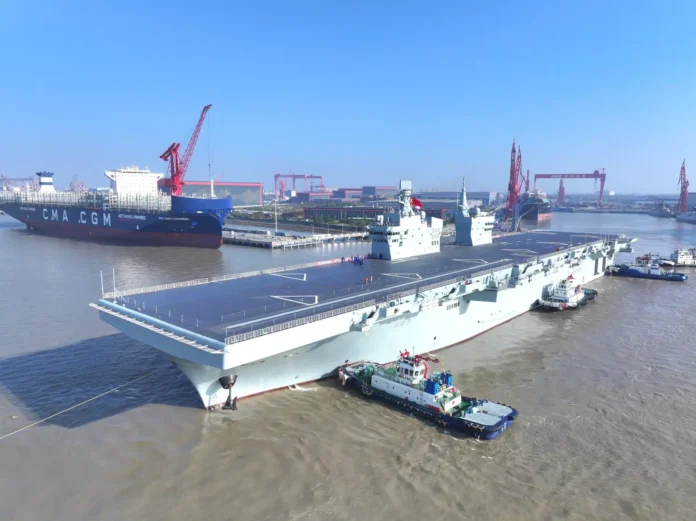
The Chinese Navy (PLAN) Type 076 amphibious assault ship Sichuan (51) has commenced her first sea trial earlier today in Shanghai. The large new amphibious carrier of a globally unique design features an electromagnetic catapult for launching fixed wing drones, Naval News reports.
Sichuan departed her berth in the morning at builder Hudong-Zhonghua on Changxing Island in the Yangtze River Delta, assisted by several tugboats. Official Chinese media channels including PLA media shared videos and high resolution imagery of the event.
Type 076 – a unique capability on one of the largest amphibs in the world
The new amphibious assault carrier measures in at an overall length of 252 metres and a beam across the flight deck of 45 metres. With these dimensions Type 076-carrier Sichuan is among the largest amphibious assault vessel-designs in the world. The ship features a welldock with the typical stern access for LCU- or LCAC-type transports, or amphibious vehicles. The flightdeck uses two side-mounted elevators for moving aircraft to the hangar below, a first for a Chinese amphibious design.
With an estimated displacement around 45,000 tons the vessel roughly matches the America-class LHD in service with the US Navy and surpasses the French nuclear-powered aircraft carrier Charles de Gaulle. Official Chinese media reported her displacement at “over 40,000 tons” back in December 2024, when Hudong launched the ship from the builders drydock.
Since then Sichuan has spent her time so far in the fitting out-basin, together with several other newly launched vessels, including new Type 054AG frigates for the PLAN, and Type 054-based offshore patrol vessels for the Chinese Coast Guard (CCG). In October this year new imagery showed dead load-testing of the electromagnetic catapult underway on the ship. Additionally, Sichuanreceived distinct flight deck markings for landing positions of helicopters or VTOL drones. The ship is still missing other regular deck markings, suggesting the present layout is temporary in nature.
Technological overlap with aircraft carrier Fujian
The catapult installed on Sichuan appears to be broadly comparable to the three electromagnetic launchers on recently commissioned aircraft carrier Fujian. In addition to the single electromagnetic catapult track, the new ship features arrested recovery gear with three arrestor wires for a true CATOBAR-configuration.
Notably, Fujian spent several more months between her own dead load-testing back in November 2023 and her first sea trial in May 2024. Meanwhile, only a few weeks had passed between those activities for Sichuan. There are likely several factors explaining the difference. For one, as an LHA the new design faces overall less complex fitting out and testing work compared to the first Chinese supercarrier with a displacement of more than 80,000 tons.
The quick progression is emblematic for construction of Sichuan. Hudong had laid down first modules in the drydock at Changxing by October 2023. Therefore the ship, as a first of class-design, progressed to sea trials within only two years.
Fixed wing combat drones as standout-feature
Next steps would involve at least several sea trials increasing in complexity and duration. However, if the rapid transition from dead load-testing to first sea trial is indicative, the ship will plausibly conduct fewer than the nine sea trials Fujian undertook before her commissioning on November 5, less than two weeks ago. The most notable event of these trials will be embarking and flight tests of the fixed wing drones destined to operate from Sichuan. Based on communicated information and imagery, at least the GJ-21, a derivative of the GJ-11 jet-powered combat drone will be part of the Sichuan carrier air wing.
The GJ-21 is a stealthy subsonic flying wing with an estimated MTOW mass of >15 tons and internal weapon bays. A single turbofan powers the drone adapted with catapult-compatible landing gear and a tailhook for arrested landings. The GJ-21 recently surfaced in new imagery dating from at least late October, suggesting flight testing is progressing.
The GJ-11-adaption however is unlikely to remain the only naval fixed wing drone operating from Sichuan and notional further carriers of this design. In a widely covered military parade in Beijing on September 3 the PLA displayed a range of new combat drones.
Number and types of drones onboard Sichuan uncertain for now
The event included four fixed wing combat drone designs, in addition to the GJ-21 and an armed GJ-2 MALE drone. Two of the new jet-powered designs feature a twin wheel front landing gear. This detail in itself is not indicative of a naval application. That said, carrier-based aircraft typically feature a twin wheel-design for more robust landing capability on compact naval flight decks. Some observers have also suggested crewed fixed wing operations from Type 076. However, the relatively compact straight flight deck appears to make such an application challenging and unsafe.
In addition to fixed wing drones the carrier will operate helicopters for different roles, such as utility/transport, assault and search and rescue. Notionally the ship will also operate rotary-wing drones. One obvious candidate is the design also included in the military parade back in September.
With sea trials now underway, Sichuan further underscores PLAN ambitions rapidly and comprehensively expanding their blue water capabilities. PLAN at present does not appear to pursue a capability comparable to the STOVL F-35B carrier/LHD-based fighter jet. Nevertheless, should further Type 076-configuration follow Sichuan into service, PLAN would possess a globally unique capability to project airpower in support of amphibious assaults across a range of scenarios.



